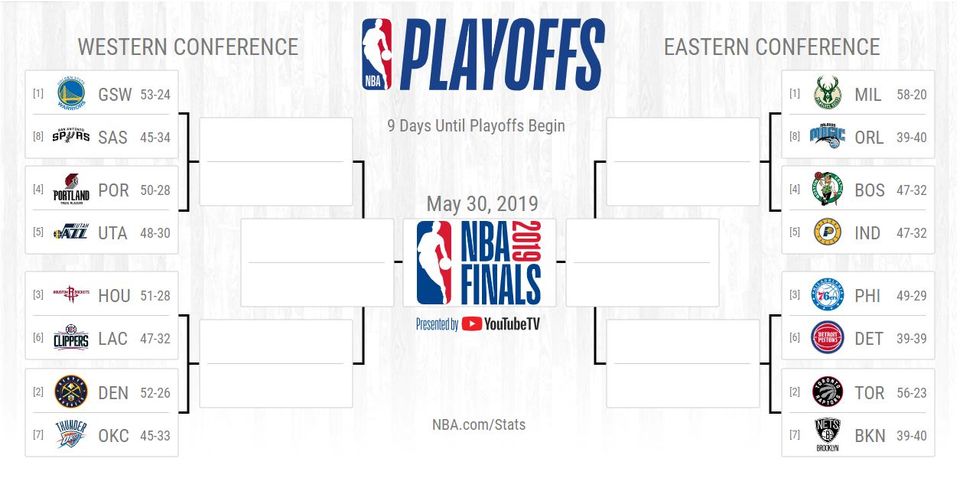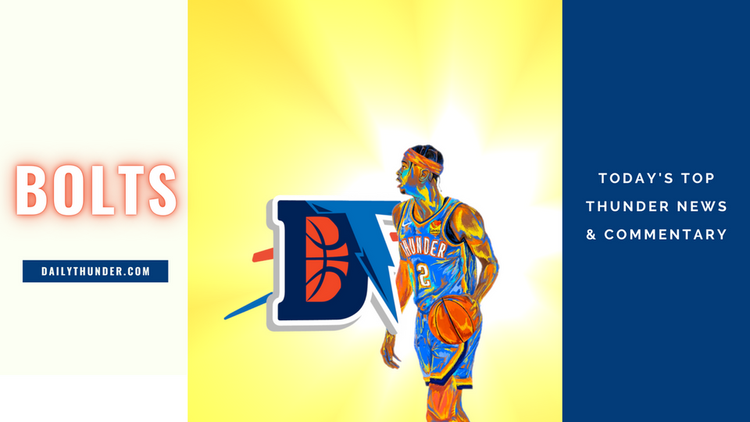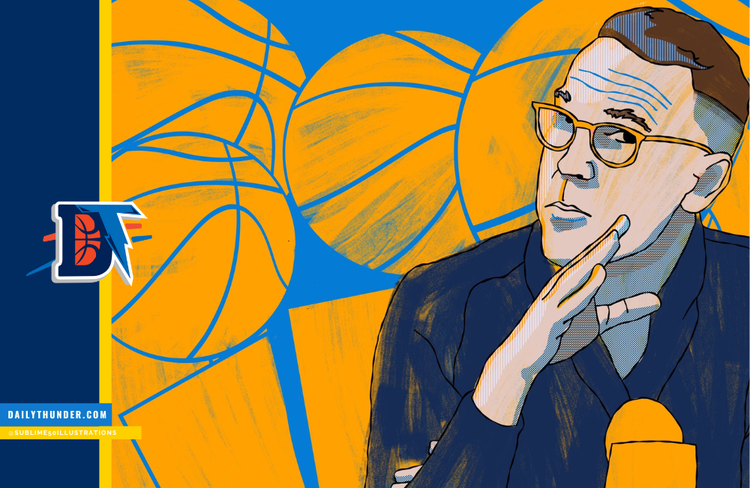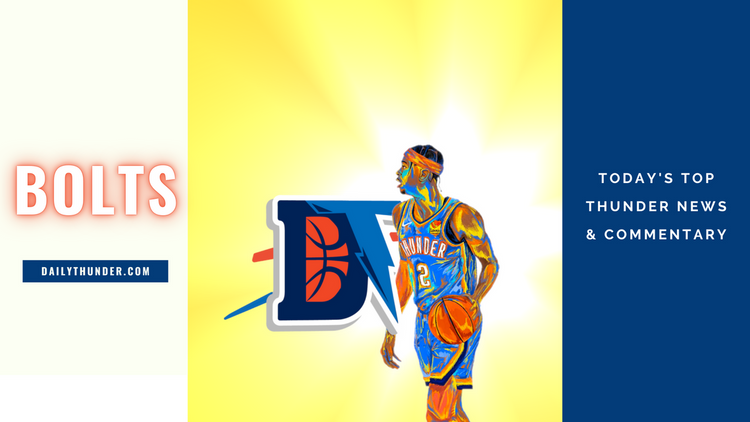Thursday Bolts: 4.4.19

Updated Playoff Picture: Happy Thursday, folks. The Thunder are back in the 7-seed.

Maddie Lee (Oklahoman) on Russell Westbrook’s 17th technical getting rescinded by the league: “The League Office review process rescinded what would have been Westbrook’s 17th technical foul of the season. Westbrook entered the Thunder’s game against the Lakers Tuesday still two regular-season technicals away from a second suspension. Westbrook was originally handed the since-rescinded technical Sunday in the third quarter of the Thunder’s 106-103 loss to the Mavericks. Westbrook drew a foul as he drove to the basket with 2:39 left in the period. After the play, he spun all the way around to pull his arm away from Mavericks guard Devin Harris. The resulting technical foul was the third Westbrook has had rescinded this season. He leads the league in technicals with 16.”
Paul Kasabian (B/R) on why OKC’s depth and 3-point shooting will limit postseason success: “Dennis Schroder is the only Thunder player averaging six or more points per game off the bench, and he’s struggling through the worst statistical season of his career since his rookie campaign in 2013-14. Per Basketball Reference, his below-average 12.5 player efficiency rating (15.0 is average) is his worst mark since 2014. Furthermore, in a league where teams are living and dying by the three-pointer, Oklahoma City is somehow surviving despite its low marks. The Thunder rank 23rd in three-point percentage: No team below them on the list is headed to the playoffs this year. In addition, the league-average three-point shooting rate is 35.5 percent, per Basketball Reference. Only three players (Grant, George and Ferguson) eclipse that mark, with no one hitting more than 38.8 percent.”
Erik Horne (Oklahoman) on why OKC’s ability to play in the halfcourt will be the key: “When the playoffs arrive, offenses grind to a halt with fewer possessions. Per basketball-reference.com, the league average for pace (possessions per 48 minutes) was 97.3 in the 2017-18 regular season. That slowed to 95.4 in the playoffs. With better opposition and shortened rotations, turnover rates decrease. Opportunities to run shrink. Halfcourt possessions become invaluable. So, there’s optimism in Tuesday’s performance, regardless of the opponent. The Thunder led by as many as 18, but the Lakers shaved the lead to nine midway through the third quarter. That’s when Westbrook passed to George in the post. George passed to Dennis Schroder at the 3-point line, and Schroder could have pulled up for 3, but immediately pump-faked and re-posted George on the shorter Kentavious Caldwell-Pope for a smooth fadeaway jump shot.”
Clay Horning (Norman Transcript) on there being no good matchups for Patrick Patterson: “Patterson, who typically spelled Jerami Grant at the four-position — power forward — until the Thunder acquired Morris over the All-Star break, had only seen action in four of the Thunder’s last 20 games prior to Tuesday. Since his arrival, entering Tuesday, Morris had averaged 15.6 minutes, 5.7 points and 3.2 rebounds, playing in every game but one — against Brooklyn, March 13 — a game in which he was not in uniform. Here’s what Donovan said that did not appear to make a lot of sense: “We’ll have to see, you know, a lot of that’s based on matchups and things like that,” he said. If that’s the case, Patterson hasn’t been the right matchup against 15 different NBA teams. Additionally, on the night Morris did not play against Brooklyn, nor did Patterson. Here’s what Donovan said that made all kinds of sense: “I think, right now,” he said, “for us, you have to look at everything.”
Dan Devine (Ringer) on Russell Westbrook’s historic tribute to Nipsey Hussle: “Twenty plus 20 plus 20,” Westbrook told TNT’s Jason Terry during an on-court postgame interview. “They know what that means, man, and that’s for my bro.” And those of us who didn’t—those of us who aren’t from some places where you probably can’t go? We learned: 20 plus 20 plus 20 equals 60. Or, more to the point, the 60s, the South Los Angeles neighborhood Hussle called home. As our Micah Peters wrote after attending an impromptu memorial for Hussle in front of the Marathon Clothing store where he was shot, “Hussle’s music tells the story of a violent, desperate 60s—the area of Hyde Park where, in his formative years, he’d seen more than enough of the life he didn’t want. It also tells of how he worked toward building the life he did want, but at home.” Hussle had spoken openly in his music and in interviews about his affiliation as a young man with the Rollin’ 60s Neighborhood Crips, but had long since left gang-banging behind to focus on supporting and enriching his community and its residents through reinvestment and philanthropy. He had reportedly been slated to participate in a Monday meeting between representatives from Jay-Z’s Roc Nation entertainment group and the Los Angeles Police Department about how to curb gang violence in the city.”
Grant Hughes (B/R) on how Russell Westbrook made the One-Man Show a viable path to MVP: “Russell Westbrook’s envelope-pushing 2016-17 season proved league-altering advances could take many forms. He averaged the first triple-double since Oscar Robertson in 1961-62, which forced us to reconsider the degree to which an individual could impact a game theoretically designed for team play. Westbrook’s 41.7 percent usage rate set an NBA record (which still stands), and his nightly stat-stuffing was the product of an energy level that felt otherworldly. It was a triumph of will as much as stamina and athleticism. Though he should have grown exhausted from the effort, Westbrook also put together one of the great clutch seasons of all time. His usage rate in close-and-late situations exploded to 60 percent, and his on-court net rating stood at 24.4 points per 100 possessions. Both led the league by a mile. One player, we thought, couldn’t possibly exert this level of control over a game—not without torpedoing his team in the process. But Westbrook blew that narrative apart and put up numbers not seen in a half-century while also producing wins in the process. Led by his complete late-game takeovers, OKC went 25-15 in games that featured clutch situations. His MVP was a reward for never-before-seen individualism.”
Steve Lackmeyer (Oklahoman) on the Thunder’s proposal to bring back Thunder Alley: “The Oklahoma City Thunder is teaming up with Hogan Property Co., developer of Lower Bricktown, to build Thunder Alley, an entertainment and dining complex proposed for the former Interstate 40 right-of-way just south of Chesapeake Energy Arena. The proposal, a response to requests issued by the Oklahoma City Urban Renewal Authority, would create the entertainment block between E.K. Gaylord Boulevard and Robinson Avenue and along the north side of Oklahoma City Boulevard. If approved by the Urban Renewal Authority, the proposal calls for construction to start by spring 2020 with an opening a year later. Randy Hogan, who developed Lower Bricktown and East Wharf, said Tuesday the complex is designed to create a year-round attraction that can host summer basketball camps, corporate events and festivals. An iconic basketball with a mirror finish will anchor the plaza across from the future Omni Hotel, and is envisioned by the developers to become “the place for photographic opportunities in Oklahoma City.”



